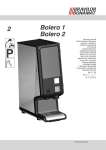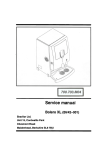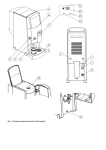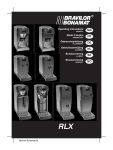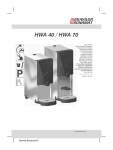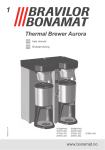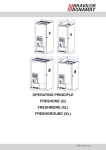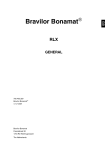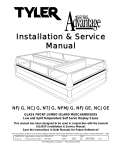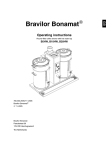Download BRAVILOR BONAMAT Bolero 10 Specifications
Transcript
Bolero 1 Bolero 2 OPERATING PRINCIPLE ECopyright Bravilor Bonamat B.V. © 2011 Bravilor® Bonamat® All rights reserved. No part of this document may be copied and/or published by means of printing, photocopying, microfilming or by any other means whatsoever without the prior written consent of the manufacturer. This applies equally to the associated drawings and/or diagrams. The information contained in this document is based on general data concerning the construction, materials characteristics and working methods known to us at the time of publication, so we reserve the right to make changes without notice. For this reason the instructions contained in this document should be treated as a guide to the installation, maintenance and repair, of the machines indicated on the front cover. This document applies to the machines in its standard form. The manufacturer therefore accepts no liability for any damage or injury arising from specifications that deviate from the standard form of the machines as supplied to you. Every possible care has been taken in the production of this document but the manufacturer accepts no liability for any errors in this document or for any consequences arising therefrom. ECopyright Bravilor Bonamat B.V. 1. OPERATING PRINCIPLE . . . . . . . . . . . . . . . . . . . . . . . . . . . . . . . . . . . . . . . . . . 1.1 General operation . . . . . . . . . . . . . . . . . . . . . . . . . . . . . . . . . . . . . . . . . . . . . . . . . . . . . . 1.2 Water dosing system . . . . . . . . . . . . . . . . . . . . . . . . . . . . . . . . . . . . . . . . . . . . . . . . . . . 1.3 Start−up . . . . . . . . . . . . . . . . . . . . . . . . . . . . . . . . . . . . . . . . . . . . . . . . . . . . . . . . . . . . . . . 1.3.1 1.3.2 1.3.3 1.3.4 1.4 1.5 1.6 1.7 Initialisation . . . . . . . . . . . . . . . . . . . . . . . . . . . . . . . . . . . . . . . . . . . . . . . . . . . . . . . . Filling . . . . . . . . . . . . . . . . . . . . . . . . . . . . . . . . . . . . . . . . . . . . . . . . . . . . . . . . . . . . . Heating . . . . . . . . . . . . . . . . . . . . . . . . . . . . . . . . . . . . . . . . . . . . . . . . . . . . . . . . . . . . Dosing . . . . . . . . . . . . . . . . . . . . . . . . . . . . . . . . . . . . . . . . . . . . . . . . . . . . . . . . . . . . Powder dosing system . . . . . . . . . . . . . . . . . . . . . . . . . . . . . . . . . . . . . . . . . . . . . . . . . Mixing system . . . . . . . . . . . . . . . . . . . . . . . . . . . . . . . . . . . . . . . . . . . . . . . . . . . . . . . . . Ventilation system . . . . . . . . . . . . . . . . . . . . . . . . . . . . . . . . . . . . . . . . . . . . . . . . . . . . . Operating system . . . . . . . . . . . . . . . . . . . . . . . . . . . . . . . . . . . . . . . . . . . . . . . . . . . . . . 1.7.1 1.7.2 Keyboard . . . . . . . . . . . . . . . . . . . . . . . . . . . . . . . . . . . . . . . . . . . . . . . . . . . . . . . . . . Main board . . . . . . . . . . . . . . . . . . . . . . . . . . . . . . . . . . . . . . . . . . . . . . . . . . . . . . . . . 1.8 Hardware protections . . . . . . . . . . . . . . . . . . . . . . . . . . . . . . . . . . . . . . . . . . . . . . . . . . 1.8.1 1.8.2 1.8.3 Back−flow protection . . . . . . . . . . . . . . . . . . . . . . . . . . . . . . . . . . . . . . . . . . . . . . . . Boiling protection . . . . . . . . . . . . . . . . . . . . . . . . . . . . . . . . . . . . . . . . . . . . . . . . . . . Overflow protection . . . . . . . . . . . . . . . . . . . . . . . . . . . . . . . . . . . . . . . . . . . . . . . . . 1.9 Software protection . . . . . . . . . . . . . . . . . . . . . . . . . . . . . . . . . . . . . . . . . . . . . . . . . . . . 1.10 Programming . . . . . . . . . . . . . . . . . . . . . . . . . . . . . . . . . . . . . . . . . . . . . . . . . . . . . . . . . . ECopyright Bravilor Bonamat B.V. 1 1 2 4 4 4 4 5 6 7 7 8 8 8 9 9 9 9 10 11 Fig. 1 The water dosing system . . . . . . . . . . . . . . . . . . . . . . . . . . . . . . . . . . . . . . . . . . . . . . . . . . . . . . . . Fig. 2 Float tank, complete . . . . . . . . . . . . . . . . . . . . . . . . . . . . . . . . . . . . . . . . . . . . . . . . . . . . . . . . . . . . Fig. 3 Pump motor + rotor . . . . . . . . . . . . . . . . . . . . . . . . . . . . . . . . . . . . . . . . . . . . . . . . . . . . . . . . . . . . . Fig. 4 Pump housing . . . . . . . . . . . . . . . . . . . . . . . . . . . . . . . . . . . . . . . . . . . . . . . . . . . . . . . . . . . . . . . . . . Fig. 5 Encoder . . . . . . . . . . . . . . . . . . . . . . . . . . . . . . . . . . . . . . . . . . . . . . . . . . . . . . . . . . . . . . . . . . . . . . . Fig. 6 Exhaust hood . . . . . . . . . . . . . . . . . . . . . . . . . . . . . . . . . . . . . . . . . . . . . . . . . . . . . . . . . . . . . . . . . . Fig. 7 Mixing unit . . . . . . . . . . . . . . . . . . . . . . . . . . . . . . . . . . . . . . . . . . . . . . . . . . . . . . . . . . . . . . . . . . . . . Fig. 8 Ventilation system . . . . . . . . . . . . . . . . . . . . . . . . . . . . . . . . . . . . . . . . . . . . . . . . . . . . . . . . . . . . . . Fig. 9 LCD display with error message . . . . . . . . . . . . . . . . . . . . . . . . . . . . . . . . . . . . . . . . . . . . . . . . . . Fig. 10 Door open . . . . . . . . . . . . . . . . . . . . . . . . . . . . . . . . . . . . . . . . . . . . . . . . . . . . . . . . . . . . . . . . . . . . Fig. 11 Programming key . . . . . . . . . . . . . . . . . . . . . . . . . . . . . . . . . . . . . . . . . . . . . . . . . . . . . . . . . . . . . . Fig. 12 Total counter . . . . . . . . . . . . . . . . . . . . . . . . . . . . . . . . . . . . . . . . . . . . . . . . . . . . . . . . . . . . . . . . . . Fig. 13 Day counter . . . . . . . . . . . . . . . . . . . . . . . . . . . . . . . . . . . . . . . . . . . . . . . . . . . . . . . . . . . . . . . . . . . Fig. 14 Day counter to zero . . . . . . . . . . . . . . . . . . . . . . . . . . . . . . . . . . . . . . . . . . . . . . . . . . . . . . . . . . . . Fig. 15 General selection screen . . . . . . . . . . . . . . . . . . . . . . . . . . . . . . . . . . . . . . . . . . . . . . . . . . . . . . . Fig. 16 Descaling symbol . . . . . . . . . . . . . . . . . . . . . . . . . . . . . . . . . . . . . . . . . . . . . . . . . . . . . . . . . . . . . . Fig. 17 Programming key / Door closed . . . . . . . . . . . . . . . . . . . . . . . . . . . . . . . . . . . . . . . . . . . . . . . . . ECopyright Bravilor Bonamat B.V. 2 2 5 5 5 7 7 7 10 11 11 11 11 11 11 12 12 1. OPERATING PRINCIPLE 1.1 General operation The machine works according to a pump system developed by Bravilor Bonamat. This system has the following advantages: D The components that are responsible for the correct dosing of the water are housed in a cold water unit. As a result, the largest cause of faults with machines, the formation of scale on the dosing valves, is limited to a minimum. D The float that regulates the water level is also located in the cold−water circuit. This is another reason why the formation of scale is limited to a minimum. ECopyright Bravilor Bonamat B.V. 1.2 Water dosing system After a selection key is pressed, the pump motor is driven with a controlled time and speed. The pump rotor displaces a certain amount of cold water from the cold water reservoir to the bottom of the boiler. As a result, the hot water in the boiler is pushed upwards towards the mixing system. Depending on the selected beverage, an ingredient is dosed which, together with the dosed water, is or is not mixed and poured into a cup. ÁÁÁÁ ÁÁÁÁ ÁÁÁÁ ÁÁ ÁÁÁÁ ÁÁÁÁ 2. Á Á Á ÁÁ ÁÁ Á Á A E B D ÁÁ ÁÁ C Fig. 2 Float tank, complete 3.B. 1. 3.A. 3.C. Fig. 1 The water dosing system ECopyright Bravilor Bonamat B.V. The water dosing system consists of the following main components: 1. Magnetic valve 2. Float tank, complete A. Float B. Pump motor C. Pump rotor D. Pump housing E. Encoder 3. Element complete (boiler) A. Element B. Temperature sensor high (NTC) C. Temperature sensor low (NTC) ECopyright Bravilor Bonamat B.V. 1.3 Start−up 1.3.1 Initialisation 1.3.3 The machine is switched on with the main switch. On the LCD (Liquid Crystal Display) the following appear in succession: D all symbols that the display can show. D the version number of the software (microprocessor) loaded from the factory. D the version of the software table (Eeprom), also loaded from the factory. This process takes approx. 3 seconds and ends with the steaming cup in the LCD display to show that this phase has successfully finished. 1.3.2 Filling The float tank and the boiler are connected by a siphon hose. Together, they form a communicating vessel. When the machine is switched on for the first time, the float tank (fig.2 ) will be empty and the float (fig.2 A.) will be low. D The magnetic valve (fig.1 ,1.) is opened and fills water in the float tank with a speed of 2 litres per minute, depending on the pressure. D The water in the float tank flows to the boiler through the hose under the float tank. D After the water level has pushed the float upwards, the water level in the float tank is the same as that of the boiler. The magnetic valve is switched off. D A signal sounds when the level of the float is reached. Please note: Because the float tank is filled faster than the water ”drops” to the boiler, the filling process will be made with short intervals. Heating After the system is completely filled with water, element (fig.1 ,3.A.) is switched on by means of a relay in the machine. The temperature sensor (fig.1 ,3.B.), which is mounted on the outside of the boiler, measures the actual temperature of the water. This ensures that the water in the boiler is heated to the desired final temperature. During the heating, a thermometer flashes in the LCD display. This indicates that the machine is not yet ready for use. The temperature sensor is of the type NTC (Negative Temperature Coefficient). The higher the measured temperature the lower the resistance of the sensor. Hot water has a lower specific weight than cold water. As a result, the hot water in the boiler will not want to flow back to the float tank through the siphon hose at the bottom. That part of the system will therefore remain cold. The latter is very important because precisely the parts of the float tank are sensitive for scale. The temperature sensor is mounted on the outside of the boiler. As a result, there is no feed−through in the wall and therefore there cannot be any long−term leakage. This measurement is less direct. This is why the temperature is regulated proportionally. The heating switches on for a certain time and off for a certain time. After the period that the heating has been off, a measurement is made. The next time, the heating will be on for longer or shorter. The higher the temperature in the boiler, the shorter the moments become that the element is on, and the longer the intermediate time becomes. In this way, an accurate temperature is obtained in the boiler. There is a second temperature sensor on the boiler (fig.1 ,3.C.). This sensor monitors the outlet temperature of the dosed water. If this sensor measures a too low temperature, the machine is blocked. No more water is dosed. ECopyright Bravilor Bonamat B.V. 1.3.4 Dosing Dosing is allowed when: D The float is in the top position. D After a selection key is pressed, the pump motor (fig.3 ) is driven for a certain time, depending on the programmed amount, with a certain speed (number of revolutions). The volume of the displaced liquid (yield) is mainly determined by the time and speed of the pump motor. The time that the motor is on is regulated from the software and is very accurate. The number of revolutions of the motor is measured with an active revolution counter. Figure 5 shows that a disc is mounted on the shaft of the pump motor (A = Encoder). This disc rotates at the same speed as the pump rotor. The encoder rotates between a light sensor (B) and interrupts a light beam. The interruption of the light beam is converted to pulses that can be read by the electronics. A B Fig. 3 Pump motor + rotor D The pump rotor rotates in the pump chamber, which is filled with water. This is formed by the bottom of the float tank and the underneath of the pump housing (fig.4 ). Fig. 5 Encoder This forms an active revolution regulation that guarantees that, during the time that the pump motor is on, the speed and thus the water yield remain constant. Fig. 4 Pump housing D The pump rotor pumps the water out of the pump chamber, through the siphon hose in the bottom of the boiler. D As a result, the hot water in the boiler is pushed out of the boiler. D The float and the magnetic valve ensure that the level in the float tank is maintained and that water remains in the pump chamber. ECopyright Bravilor Bonamat B.V. 1.4 Powder dosing system The powder dosing system consists of an ingredient holder (canister) that is driven by a motor (canister motor). After the start key is pressed, the canister motor will rotate after a certain delay. This motor drives a worm, which transports the ingredient to the canister outlet. The control of the canister motor makes it possible to regulate timing and dosing speed independently. As a result, the ingredient can be poured into the mixer at the same time that the water flows out. However, the canister motor will stop slightly earlier than the water, to rinse the mixing jug clean. Depending on the type of ingredient, “beater springs” are used in the canister. These springs ensure that less tunnel formation occurs. This is the caking of ingredient against the walls. ECopyright Bravilor Bonamat B.V. 1.5 Mixing system 1.6 The mixing unit (fig.7 ) mixes the hot water and the ingredient. After a selection key is pressed, the water will be dosed in the mixing chamber after a certain delay. The product falls into the mixing chamber from above. Depending on the selected beverage, the mixer will start to rotate with a certain number of revolutions. An exhaust opening is mounted on top of the mixing chamber (fig.6 ). This cover has an opening at the rear, which is pressed into an exhaust opening through the sheet−metal work. The function of this exhaust system is to ensure that vapour from the mixing chamber does not get the chance to reach the ingredient holder outlet. Ventilation system The ventilation system (fig.8 ) removes the steam, that developes during dosing. So the settling of warm steam and condensation in the mixing chamber will be prevented. Therefore the mixing chamber will get less dirty. Fig. 8 Ventilation system Fig. 6 Exhaust hood Fig. 7 Mixing unit ECopyright Bravilor Bonamat B.V. 1.7 Operating system The operating system consists of a: D Keyboard D Main board 1.7.1 Keyboard 1.7.2 The keyboard is located on the front of the machine and contains various keys and the display. This board contains inputs and outputs of the machine and the microprocessor with memory. Saved settings such as the dosing quantities, counters, etc. are stored here. When this circuit board is replaced, the customer−specific settings will be lost. A flat cable connects the keyboard to the main board in the machine. Main board The main board is located on the rear inside the machine and it is supplied from an external transformer. This board contains a number of components that convert the alternating current of the transformer into 24 V direct current. The main board also contains the relay for controlling the heating element. ECopyright Bravilor Bonamat B.V. 1.8 Hardware protections The machine is equipped with a number of hardware protections. These protections ensure that no dangerous situations can arise, such as overheating and/or water in the machine. 1.8.1 Back−flow protection The water from the magnetic valve is sprayed against the cover through a pipe in the cold water tank. Then it flows into the cold water tank. In this way, water is prevented from flowing back into the system and getting into the water system when the water pressure is released from the magnetic valve. 1.8.2 Boiling protection The boiling−dry protection is mounted on the outside of the boiler by means of two Klixons. If the boiler, for whatever reason, is not switched off by the control, the Klixons make sure that the voltage on the element is mechanically switched off to prevent overheating. 1.8.3 Overflow protection This protection is located in the cold water tank and ensures that, when the water level is too high, excess water is passed through the overflow hose at the bottom of the machine. ECopyright Bravilor Bonamat B.V. 1.9 Software protection The machine has been equipped with a number of software protections; the software monitors all inputs and outputs of the machine throughout the process. If non−allowed situations arise, the software will intervene. This intervention results in the machine being switched off and an error message being shown on the display. Fig. 9 LCD display with error message ERROR LIST Error 1 not applicable Error 2 Temperature in boiler too high: − If the temperature sensor (NTC) measures a value that is outside its range (0 Ohm or infinity), the machine is switched off and ’Error 2’ appears in the LCD display. This also applies if the boiling protection (see hardware protection) is activated. Error 3 not applicable Error 4 not applicable Error 5 not applicable Error 6 Magnetic valve opened too long: − If, for whatever reason, the process of filling the float tank takes too long, the machine is switched off and ’Error 6’ appears in the LCD display. Error 8 Communication error between both prints: − There is constant communication during machine start−up and during use. This is done via the flatcable between the keyboard and the main board. If communication is impossible, ’Error 8’ appears in the LCD display. Error 9 Pump motor rotates too slow or does not rotate at all: − The pump motor is rotating during machine start−up and during use. The light sensor detects no or too little pulses and ’Error 9’ will appear in the LCD display. Error 7 Wrong Chip card: − In a number of cases, it is possible to place a chip card in a chip card reader. This is present on the keyboard. Any data present can be downloaded or uploaded. If the software on this chip card does not correspond with the software in the machine, ’Error 7’ appears in the LCD display. ECopyright Bravilor Bonamat B.V. 1.10 Programming The programming is built up by means of a simple programming carrousel. Have the user instructions open next to this text. After the programming is activated by means of the programming key, settings can be simply activated or changed. By pressing the programming key again, the settings are saved the machine returns to the standby mode. 1. Open the door with the key. 3.1 Separate read−out of counter contents of poured beverages: − Select the desired beverage with one of the selection buttons. The relevant counter contents will appear in the LCD display. After a few seconds, the counter contents return to the counter of all beverages at the same time. 3.2 Resetting day counter: − Select any beverage using one of the selection buttons. − Keep the desired selection button pressed until the day counter is set at 0. Fig. 10 Door open 2. Press the programming key (P) to start the programming sequence. Fig. 13 Day counter Fig. 11 Programming key 3. Counter contents read−out of all beverages at the same time. The display shows a 3− and 5−digit number alternately: − The 3−digit number denotes the total number of units that were poured since the counter settings were last reset to zero (day counter). − The 5−digit number denotes the total number of units that were poured since the machine was put into operation (total counter). Fig. 12 Total counter Fig. 14 Day counter to zero − Press the Enter key to go to the general selection screen (fig.15 ). 4. General selection screen: − General programming: press the Enter key and continue with point 5. − Beverage−dependent settings: press the selection key and continue with point 9. Fig. 15 General selection screen 5. Boiler temperature: − Set the maximum temperature of the water in the boiler (min. 80_C − max. 90_C). ECopyright Bravilor Bonamat B.V. 6. Descaling signal: 9. General selection screen. − Ask your local water company about the hardness 10. Amount drink dependent: of the water supply. Always select the right − For the mug and jug selection buttons. setting. The default setting of the machine is − Setting the amount of water in ml. The software position 3 (1000L). The machine continuously will convert a larger amount to a longer pumping registers the time that the inlet valve is open and time. If the amount of water is changed, the therefore the number of litres of water that has basic strength is automatically adapted, so that passed through the system. When the number of the strength increases or decreases registered litres is greater than or equal to the proportionally. programmed value, the descaling symbol in the 10.1 Block dosing: LCD display starts to flash. − Decrease the value to the minimum. The display will show ’OFF’. 11. Basic strength drink dependent: − Setting amount of ingredient (in %). The software translates the programmed percentage to the speed of the canister motor and therefore the strength of the ingredient. (See ingredient sheet). 12. Mixer on/off: − By switching the mixer ON, the beverage is mixed and, with coffee, a layer of cream is Fig. 16 Descaling symbol obtained on the top. If this is not desired, and 7. Energy−saving mode: black coffee is required, set this option to OFF. − Setting the number of minutes/hours, after which With other ingredients such as cocoa, the mixer the machine must switch over to the ECO mode. must always be set to ON to prevent clogging. All functions such as boiler, ventilator and 13. General selection screen. display illumination switch off and [ECO] By pressing the programming key P4 again, the appears in the LCD display. The next time that a settings are saved and the machine returns to the selection key is pressed, the machine switches standby mode. on again. Depending on the switch−off time, it can take a few minutes before the machine is ready for use again. 8. Copy Card: − Customer specific settings can be copied on the chipcard, whereupon these can be downloaded to other equivalent machines. D The procedure can be found on the extranet “Special Codes”. Fig. 17 Programming key / Door closed ECopyright Bravilor Bonamat B.V. © 07−2011 ECopyright Bravilor Bonamat B.V.

















